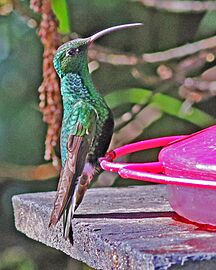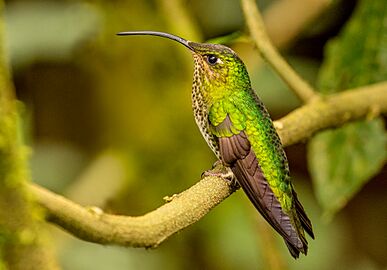Mountain velvetbreast facts for kids
Quick facts for kids Mountain velvetbreast |
|
|---|---|
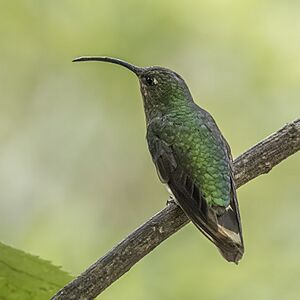 |
|
| Male | |
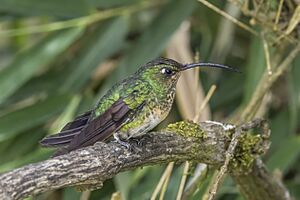 |
|
| Female both L. l. longirostris in Colombia |
|
| Conservation status | |
| Scientific classification | |
| Genus: |
Lafresnaya
|
| Species: |
lafresnayi
|
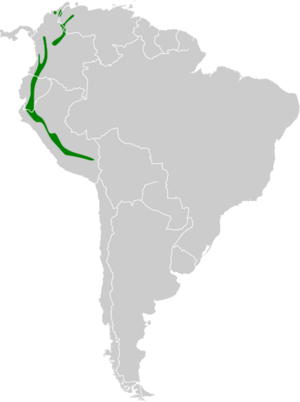 |
|
The mountain velvetbreast (Lafresnaya lafresnayi) is a beautiful hummingbird found in the mountains of Colombia, Ecuador, Peru, and Venezuela. It's known for its bright colors and unique look. This tiny bird belongs to a group of hummingbirds called "brilliants."
Contents
About the Mountain Velvetbreast Family
The mountain velvetbreast is a special bird because it's the only species in its group, called a genus. Within this species, there are seven different types, known as subspecies. These subspecies are:
- L. l. liriope
- L. l. longirostris
- L. l. greenewalti
- L. l. lafresnayi
- L. l. saul
- L. l. orestes
- L. l. rectirostris
Long ago, some people thought that two of these types, L. l. liriope and L. l. saul, were actually separate species.
What Does the Mountain Velvetbreast Look Like?
This hummingbird is about 11.5 to 12 centimeters (4.5 to 4.7 inches) long. This measurement includes its bill, which is about 2.7 to 3.2 centimeters (1.1 to 1.3 inches) long. It weighs between 4.5 and 6.3 grams (0.16 to 0.22 ounces).
Male mountain velvetbreasts have a thin, black bill that curves downwards. The length and curve of the bill can be different among the various subspecies. Females have a bill that is less curved than the male's, and its shape also changes depending on where they live. All mountain velvetbreasts have a small white spot right behind their eye.
The main type of mountain velvetbreast, called L. l. lafresnayi, has bright grass-green feathers on its upper body. Its throat and chest shine with an emerald green color, and its belly is a deep, velvety black. The feathers in the middle of its tail are a bronzy green, while the outer tail feathers are buff (a pale yellowish-brown) with black tips.
Female L. l. lafresnayi also have grass-green upper parts. Their underparts are buff with shiny green spots. Young birds look a lot like the females, but young males will start to show the black feathers on their belly.
Males of the other subspecies have white outer tail feathers instead of buff. Females of these subspecies have white underparts, not buff like the main type. Most subspecies have small differences in their bill's length and curve. For example, L. l. saul has a more curved bill, and L. l. orestes has an even more curved bill. The subspecies L. l. longirostris has the longest bill of all.
There are also slight differences in feather colors among the subspecies. L. l. liriope has coppery green central tail feathers. L. l. greenewalti looks similar to the main type but is lighter and more yellowish-green. L. l. longirostris has less coppery inner tail feathers and unique horn- to buff-colored outer tail feathers. L. l. saul has white outer tail feathers with greenish-bronze tips. L. l. orestes is mostly like the main type, but has a very curved bill and white outer tail feathers. Finally, L. l. rectirostris has a wide black band at the end of its tail feathers.
Where Do Mountain Velvetbreasts Live?
The different types of mountain velvetbreasts are found in specific areas:
- L. l. liriope lives in the isolated Sierra Nevada de Santa Marta in northern Colombia.
- L. l. longirostris is found in the northern part of Colombia's Central Andes mountains.
- L. l. greenewalti lives in the western Venezuelan states of Trujillo, Mérida, and Táchira.
- L. l. lafresnayi is found in the very southwestern Andes of Venezuela and Colombia's Eastern Andes.
- L. l. saul ranges from the Andes of southwestern Colombia, south through Ecuador, and into the very northern part of Peru.
- L. l. orestes lives on the east side of the northern Peruvian Andes, south of the Marañón River.
- L. l. rectirostris is found in the Andes mountains of northern and central Peru.
Mountain velvetbreasts mostly live at the edges of wet montane forests (mountain forests). They also like shrubby slopes. Sometimes, they can be found inside the forest, but this is less common. They usually live at elevations from 1,800 to 3,400 meters (5,900 to 11,200 feet) above sea level. They are most common between 2,000 and 2,800 meters (6,600 to 9,200 feet). In Ecuador, they are often seen up to 3,500 meters (11,500 feet) and sometimes even as high as 3,700 meters (12,100 feet).
Mountain Velvetbreast Behavior
Seasonal Movements
The mountain velvetbreast moves between lower forest areas and higher mountain grasslands, called páramo, depending on the season.
What Do They Eat?
Mountain velvetbreasts drink nectar from many kinds of plants that have long, tube-shaped flowers. They especially like flowers from the plant group called Siphocampylus. Male birds will protect their favorite feeding spots. Females, however, often visit a regular route of feeding sites, like following a map. Both male and female birds also catch small arthropods (like insects or spiders) by picking them off leaves or by catching them in the air.
Life Cycle and Reproduction
The breeding seasons for the mountain velvetbreast vary depending on the location. However, it seems they breed somewhere almost every month of the year, except for June.
They build a large, cup-shaped nest using moss, lichen, and spider silk. The nest is usually placed 1 to 3 meters (3 to 10 feet) above the ground. They often put it in plants on a steep rock face or an earthen bank. Sometimes, they build their nest on a tree trunk. The female bird sits on her two eggs for 16 to 19 days. The young birds leave the nest 23 to 26 days after they hatch.
What Sounds Do They Make?
The mountain velvetbreast makes several different calls. These include a high-pitched "tseee" or "pseeuw" sound that is repeated. Sometimes, this is followed by a quick, stuttering series of notes that go down in pitch. They also make soft "tek" notes and a thin rattling sound.
Conservation Status
The IUCN (International Union for Conservation of Nature) has evaluated the mountain velvetbreast. They have listed it as a species of "Least Concern." This means that the bird is not currently in danger of disappearing. It lives across a very large area. Even though we don't know the exact number of birds, their population is believed to be stable.
The mountain velvetbreast is common in the Sierra Nevada de Santa Marta. However, it is less common and found in scattered groups in the Andes mountains. It is also uncommon in Venezuela and Ecuador. Luckily, it lives in several protected areas in Ecuador, which helps keep its population safe.



